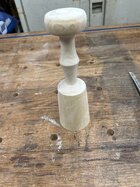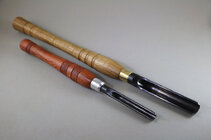Never use a spindle gouge (roughing or detail) on a side grain turning.
I have to disagree. I use spindle and spindle detail gouges a lot on side grain (face turning). I don’t use them to hog out material but mostly for deail work. With good tool control and light cuts I can’t imagine a problem.
I think one problem with roughing gouges is their name: beginners may thing they are perfect for roughing out anything. If they are always advertised and referred to as SPINDLE roughing gouge perhaps some would better understand their intended function.
But yes, there is a big potential danger with a spindle
roughing gouge on face turning, mostly due to the way they are made with a small, weak tang at the handle. People have been injured. The Thompsons have full diameter 5/8” shafts. Another problem is unlike a bowl gouge, a spindle roughing gouge presents a broad edge to the wood, far more likely to grab instead of cut with control.
Another option is the Hunter carbide tools, nothing at all like the “traditional” flat topped carbide tools. The hunters work more like a gouge although some models can be used effectively as scrapers and sheer scrapers. They will as cleanly as a gouge on both spindle and face turning, although spindle gouges are better for fine detail. One advantage with Hunter is you replace the tip instead of sharpening. The tip on my first Hunter lasted over a year before I replaced it. I use the small Hunter Hercules on nearly every bowl and platter, inside and out, shallow and moderately deep.
After some experience with the flat-topped carbide tools, I won’t use them again because of the surface reasons. I gave all mine away.
JKJ


